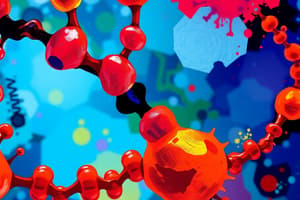Podcast
Questions and Answers
What are carbohydrate macromolecules primarily composed of?
What are carbohydrate macromolecules primarily composed of?
- Simple sugars (correct)
- Fatty acids
- Amino acids
- Nucleotides
What is the primary function of lipid macromolecules?
What is the primary function of lipid macromolecules?
Holds structural material, stores energy and signals molecules.
What is the main role of protein macromolecules?
What is the main role of protein macromolecules?
Builds bones, muscles, tissues, ligaments, hair, nails and skin.
What are nucleic acid macromolecules responsible for?
What are nucleic acid macromolecules responsible for?
What element is needed in organic macromolecules?
What element is needed in organic macromolecules?
What defines a macromolecule?
What defines a macromolecule?
What distinguishes organic molecules?
What distinguishes organic molecules?
What are inorganic molecules?
What are inorganic molecules?
What are monomers?
What are monomers?
What are polymers?
What are polymers?
What is glucose?
What is glucose?
What are simple sugars primarily used for?
What are simple sugars primarily used for?
What constitutes a complex carbohydrate?
What constitutes a complex carbohydrate?
Humans can digest cellulose.
Humans can digest cellulose.
What are lipids used for?
What are lipids used for?
What type of lipid is used for long-term energy storage?
What type of lipid is used for long-term energy storage?
What is the role of steroids in the body?
What is the role of steroids in the body?
What does hydrophobic mean?
What does hydrophobic mean?
What are hormones made of?
What are hormones made of?
What distinguishes good cholesterol from bad cholesterol?
What distinguishes good cholesterol from bad cholesterol?
What are proteins also called?
What are proteins also called?
What are amino acids?
What are amino acids?
Denatured proteins maintain their original shape.
Denatured proteins maintain their original shape.
What are enzymes?
What are enzymes?
What is the lock and key model in enzymatic reactions?
What is the lock and key model in enzymatic reactions?
What are decomposition reactions?
What are decomposition reactions?
Flashcards are hidden until you start studying
Study Notes
Carbohydrates
- Composed of simple sugars, primarily glucose, linked in long chains.
- Function as primary energy sources for cells.
- Monomer unit is glucose; complex carbohydrates like starch and glycogen serve long-term energy needs.
Lipids
- Serve as structural materials and energy storage, and function as signaling molecules.
- Hydrophobic in nature; includes oils, fats, and steroids.
- Fatty acids serve as energy storage; glycerol acts as the lipid backbone.
Proteins
- Build and repair bodily structures such as bones, muscles, and skin.
- Composed of amino acids; 20 different types lead to diverse protein structures.
- Enzymes, a special class of proteins, catalyze biochemical reactions.
Nucleic Acids
- Responsible for the storage, expression, and transmission of genetic information.
- Composed of nucleotides, which include a base, phosphate group, and either DNA or RNA.
Macromolecules
- Large organic molecules, including carbohydrates, lipids, proteins, and nucleic acids.
- Basic units (monomers) link together to form polymers (macromolecules).
Organic vs Inorganic Molecules
- Organic molecules feature carbon as a backbone and include elements like fats and sugars.
- Inorganic molecules lack carbon backbones; examples include water and carbon dioxide.
Monomers and Polymers
- Monomers are small units that combine to form larger macromolecules (polymers).
- Examples include glucose (monomer for carbohydrates) and amino acids (monomers for proteins).
Cellulose
- A complex carbohydrate humans cannot digest due to its structure, although it consists of glucose units.
- Ruminants like cows can digest cellulose effectively.
Cholesterol
- Steroids function in hormone production and signaling; cholesterol is a significant type of steroid.
- Good cholesterol (unsaturated fats) helps clear bad cholesterol (saturated fats) from blood vessels.
Protein Structure and Function
- Proteins can be denatured by temperature or pH changes, altering their original shape.
- The lock and key model illustrates how enzymes require specific substrates to function effectively in reactions.
Enzymatic Reactions
- Enzymes are catalysts that speed up chemical reactions, allowing substrates to be built or broken down more effectively.
- Key enzymes include pepsin (proteins), amylase (starches), and lipase (fats).
Studying That Suits You
Use AI to generate personalized quizzes and flashcards to suit your learning preferences.




